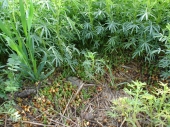posted 12 years ago
Brassicas - Cabbage, cauliflower, broccoli, turnips, kale, rutabagas, kohlrabi, mustard, and radish.
This is the perfect time to plant them; the seeds germinate quickly in hot weather and as the weather cools off, the plant puts more into growth and will not go to seed. I would suggest rolling or chopping or otherwise killing the weed crop and laying it down to dry out to a mulch, akin to how the no-till farmers kill their cover crop in preparation for planting. Many of these you can start now in flats and transplant into the mulch when they are 4" tall. However, the root crops (turnips, rutabaga, radish) do best when seeded directly onto the mulch. Don't limit yourself to western style salad radishes. Look for the Asian types, like daikon that are good cooking radishes. They have the added benefit that they loosen the soil as their roots grow deep.
Brassicas are all frost tolerant, some to lower temperatures than others. I've read where savoy cabbage is supposed to be hardy down to 0F, but we don't get any of that here in Georgia. From my experience, kohlrabi can look like a goner when the temps go down into the teens at night, but after a sunny day it springs right back. With a lot of mulch and snow cover, the root crops may just go dormant in the depths of winter and you can look forward to them resprouting in the springtime.








